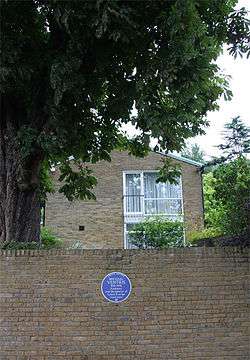Michael Ventris
| Michael Ventris | |
|---|---|
 Ventris's home, 1952–1956, which he and his wife, Lois, also an architect, designed | |
| Born |
12 July 1922 Wheathampstead, Hertfordshire |
| Died |
6 September 1956 (aged 34) Hatfield |
| Residence | 19 North End, Hampstead, London NW3, a home designed by Ventris |
| Nationality | British |
| Citizenship | United Kingdom |
| Alma mater | Architectural Association School of Architecture |
| Known for | Decipherment of Linear B |
| Spouse(s) | Lois (Knox-Niven) Ventris |
| Awards |
University of Uppsala Honorary Doctorate, 1954 Order of the British Empire, 1955 |
| Scientific career | |
| Fields | Architecture, Archaeology, Linguistics, Philology, Classics |
| Influences | Arthur Evans, Alice Kober, John Chadwick, Emmett Bennett |
| Influenced | Historiography of Aegean civilization |
Michael George Francis Ventris, OBE (/ˈvɛntrɪs/; 12 July 1922 – 6 September 1956) was an English architect, classicist and philologist who deciphered Linear B,[1] the ancient Mycenaean Greek script. A student of languages, Ventris had pursued the decipherment as a personal vocation since his adolescence. After creating a new field of study, Ventris died in an automobile accident a few weeks before the publication, with John Chadwick, of Documents in Mycenaean Greek.
Biography
Early life
Ventris was born into a traditional army family. His grandfather, Francis Ventris, was a major-general and Commander of British Forces in China. His father, Edward Francis Vereker Ventris, was a lieutenant-colonel in the Indian Army,[2] who retired early due to ill health. Edward Ventris married Anna Dorothea Janasz (Dora), who was from a wealthy Jewish (Janasz) Polish paternal background. Michael Ventris was their only child.
The family moved to Switzerland for eight years, seeking a healthy environment for Colonel Ventris. Young Michael started school in Gstaad, where classes were taught in French and German. He soon was fluent in both languages and showing proficiency for Swiss German.[3] He was capable of learning a language within a matter of weeks, which allowed him to acquire fluency in a dozen languages. His mother often spoke Polish to him, and he was fluent by the age of eight. At this time, he was reading Adolf Erman's Die Hieroglyphen in German.

In 1931, the Ventris family returned home. From 1931 to 1935 Ventris was sent to Bickley Hill School in Stowe. His parents divorced in 1935. At this time, he secured a scholarship to Stowe School. At Stowe he learned some Latin and Ancient Greek.[3] He did not do outstanding work there - by then he was spending most of his spare time learning as much as he could about Linear B, some of his study time being spent under the covers at night with a flashlight. When he was not boarding at school, Ventris lived with his mother, before 1935 in coastal hotels, and then in the avant garde Berthold Lubetkin's Highpoint modernist apartments in Highgate. His mother's acquaintances, who frequented the house, included many sculptors, painters, and writers of the day. The money for her sophisticated lifestyle came from Polish estates.
Young adult
Ventris's father died in 1938 and his mother Dora became administrator of the estate. With the German invasion of Poland in 1939, Mrs Ventris lost her private income, and in 1940 Dora's father died. Ventris lost his mother to clinical depression and an overdose of barbiturates. He never spoke of her, assuming instead an ebullient and energetic manner in whatever he decided to do, a trait which won him numerous friends. A friend of the family, Russian sculptor Naum Gabo, took Ventris under his wing. Ventris later said that Gabo was the most family he had ever had. It may have been at Gabo's house that he began the study of Russian. He decided on architecture as a career, and enrolled in the Architectural Association School of Architecture. There he met his wife Lois Knox-Niven. Her social background was similar to what Ventris's had been: her family was well-to-do, she had travelled in Europe, and she was interested in architecture, in addition to which she was popular and was considered very beautiful.

Ventris did not complete his architecture studies, being conscripted in 1942. He chose the Royal Air Force (RAF). His preference was for navigator rather than pilot, and he completed the extensive training in the UK and Canada, to qualify early in 1944 and be commissioned.[4] While training, he studied Russian intensively for several weeks, the purpose of which is not clear. He took part in the bombing of Germany, as aircrew on the Handley Page Halifax with No. 76 Squadron RAF, initially at RAF Breighton and then at RAF Holme-on-Spalding Moor.[4][5] After the conclusion of the war he served out the rest of his term on the ground in Germany, for which he was chosen because of his knowledge of Russian. His duties are unclear. His friends assumed he was on intelligence duties, interpreting his denials as part of a legal gag. No evidence of such assignments has emerged in the decades since. There is also no evidence that he was ever part of any code-breaking unit, as was Chadwick, even though the public has readily believed this explanation of his genius and success with Linear B.[6]
Architect and palaeographer
After the war he worked briefly in Sweden, learning enough Swedish to communicate with scholars in it.[3] Then he came home to complete his architectural education with honours in 1948[7] and settled down with Lois working as an architect. He designed schools for the Ministry of Education. He and his wife personally designed their family home, 19 North End, Hampstead.[8] He had two children, a son, Nikki (1942–1984) and a daughter, Tessa (born 1946).[9] Ventris continued with his efforts on Linear B, discovering in 1952 that it was an archaic form of Greek. He was awarded an OBE in 1955 for "services to Mycenaean paleography."[8]
In 1956 Ventris, who lived in Hampstead, died instantly in a late-night collision with a parked truck while driving home, aged 34. The coroner's verdict was accidental death.[10]
An English Heritage blue plaque commemorates Ventris at his home in Hampstead.[11]
Decipherment
At the beginning of the 20th century, archaeologist Arthur Evans began excavating an ancient site at Knōssos, on the island of Crete. In doing so he uncovered a great many clay tablets inscribed with two unknown scripts, Linear A and Linear B. Evans attempted to decipher both in the following decades, with little success.
In 1936, Evans hosted an exhibition on Cretan archaeology at Burlington House in London, home of the Royal Academy. It was the jubilee anniversary (50 years) of the British School of Archaeology in Athens, contemporaneous owners and managers of the Knossos site. Evans had given the site to them some years previously. Villa Ariadne, Evans's home there, was now part of the school. Boys from Stowe school were in attendance at one lecture and tour conducted by Evans himself at age 85. Ventris, 14 years old, was present and remembered Evans walking with a stick. The stick was undoubtedly the cane named Prodger which Evans carried all his life to assist him with his short-sightedness and night blindness. Evans held up tablets of the unknown scripts for the audience to see. During the interview period following the lecture, Ventris immediately confirmed that Linear B was as yet undeciphered, and determined to decipher it.
In 1940, the 18-year-old Ventris had an article Introducing the Minoan Language published in the American Journal of Archaeology.[12] Ventris's initial theory was that Etruscan and Linear B were related and that this might provide a key to decipherment. Although this proved incorrect, it was a link he continued to explore until the early 1950s.
Shortly after Evans died, Alice Kober noted that certain words in Linear B inscriptions had changing word endings — perhaps declensions in the manner of Latin or Greek. Using this clue, Ventris constructed a series of grids associating the symbols on the tablets with consonants and vowels. While which consonants and vowels these were remained mysterious, Ventris learned enough about the structure of the underlying language to begin guessing. Alice Kober was a classics professor at Brooklyn College and had done extensive work on Linear B. Ventris acknowledged her work as having made a significant contribution to his own work.[13] [14]
Shortly before World War II, American archaeologist Carl Blegen discovered a further 600 or so tablets of Linear B in the Mycenaean palace of Pylos. Photographs of these tablets by archaeologist Alison Frantz facilitated Ventris's later decipherment of the Linear B script.[15]
Comparing the Linear B tablets discovered on the Greek mainland, and noting that certain symbol groups appeared only in the Cretan texts, Ventris made the inspired guess that those were place names on the island. This proved to be correct. Armed with the symbols he could decipher from this, Ventris soon unlocked much text and determined that the underlying language of Linear B was in fact Greek. This overturned Evans's theories of Minoan history by establishing that Cretan civilization, at least in the later periods associated with the Linear B tablets, had been part of Mycenean Greece.
See also
Notes
- ↑ http://www.cam.ac.uk/research/news/cracking-the-code-the-decipherment-of-linear-b-60-years-on
- ↑ Great Britons: Twentieth-century lives, Harold Oxbury, 1985
- 1 2 3 Chadwick 1990, p. 2.
- 1 2 "Royal Air Force (Volunteer Reserve) (RAF(VR)) Officers 1939–1945". Retrieved 11 April 2012.
- ↑ Robinson, pp45-7
- ↑ Palaima 2000, p. 1.
- ↑ Oxbury, Harold (1985). Great Britons: twentieth-century lives. Oxford; New York: Oxford University Press. p. 338.
- 1 2 chadwick 1990, p. 3.
- ↑ ohk (2006), The Ventris Papers (PDF), School of Advanced Studies, University of London
- ↑ Robinson p151
- ↑ "VENTRIS, MICHAEL (1922–1956)". English Heritage. Retrieved 2012-10-22.
- ↑ Robinson, pp32-3
- ↑ Fox, Margo, The Riddle of the Labyrinth, ecco, 2013
- ↑ Kahn, David, The Code-Breakers, MacMillan, 1967
- ↑ McCredie, James R. (June 2000). "Biographical Memoirs: Alison Frantz" (PDF). Proceedings of the American Philosophical Society. 144 (2): 213–217. Archived from the original (PDF) on 2 November 2013. Retrieved 15 October 2013.
Bibliography
By Ventris alone or jointly
- Ventris, M. G. F. Introducing the Minoan Language, essay article in American Journal of Archaeology XLIV/4 October-December 1940.
- Ventris, Michael (1950). The languages of the Minoan and Mycenaean civilizations: mid-century report. London: Michael Ventris.
- —— (1951). A preliminary analysis of the language contained in the Mycenaean Archives from Pylos in Messenia.
- ——; Chadwick, John (1953). "Evidence for Greek Dialect in the Mycenaean Archives". The Journal of Hellenic Studies. 73: 84–103. JSTOR 628239.
- —— (1954). King Nestor's Four-handled Cups: Greek Inventories in the Minoan Script. Indianapolis: Bobbs-Merrill.
- ——; Chadwick, John (1956A). Documents in Mycenaean Greek. Cambridge: Second edition (1974). Cambridge UP. ISBN 0-521-08558-6.
- —— (1956B). Mycenaean furniture on the Pylos tablets. Uppsala: Eranos förlag.
- ——; Sacconi, Anna (1988). Work notes on Minoan language research and other unedited papers. Incunabula Graeca, 90. Roma: Edizioni dell'Ateneo.
By others
- Chadwick, John (1990) [1958]. The Decipherment of Linear B (2nd ed.). Cambridge University Press. ISBN 0-521-39830-4.
- Fox, Margalit (2013). The Riddle of the Labyrinth: The Quest to Crack an Ancient Code. Ecco. ISBN 978-0062228833.
- Robinson, Andrew (2002). The Man Who Deciphered Linear B: The Story of Michael Ventris. New York: Thames & Hudson Ltd. ISBN 0-500-51077-6.
- Palaima, Thomas G (2000). Unlocking the Secrets of Ancient Writing: The Parallel Lives of Michael Ventris and Linda Schele and the Decipherment of Mycenaean and Mayan Writing: Catalogue of an Exhibition in Conjunction with the Eleventh International Mycenological Colloquium (PDF). Austin: University of Texas at Austin. ISBN 0-9649410-4-X.
External links
- BBC (2005). Michael Ventris Videos. OVGuide. Archived from the original on 17 October 2013. Retrieved 12 April 2012.
- "Michael Ventris Papers" (PDF). Program in Aegean Scripts and Prehistory (PASP), Classics Department, University of Texas at Austin. Retrieved 13 April 2012.
- Engels, Tom. "Michael Ventris: Decipherer of Linear B". 66South.com. Archived from the original on 28 June 2013. Retrieved 13 April 2012.